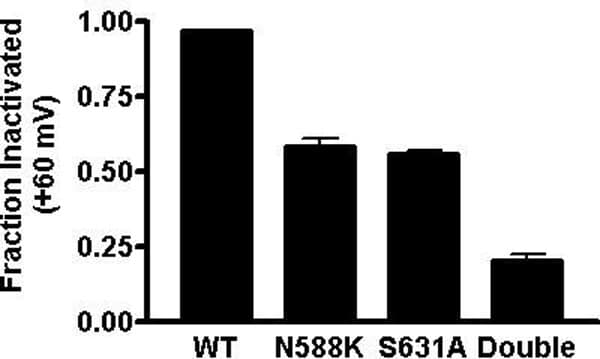Drugs that block hERG are proposed as a potential adjunct therapy for the SQT1 form of the arrhythmogenic disorder short QT syndrome. High affinity hERG blockers are known to have their hERG inhibition attenuated by the S631A mutation and by the N588K mutation of hERG, both of which result in attenuated inactivation. Here we use the S631A/N588K double mutant to show that both mutations together are synergistic in both attenuating inactivation and in reducing blockade by E-4031, a high affinity hERG blocker. Whole-cell patch-clamp of transfected mammalian cells (CHO), using a K+ based pipette solution and normal Tyrode’s extracellular solution at 37°C, was performed with the wild type (WT) channel and the 3 mutants. To determine potency, concentration response curves were fitted to a Hill equation after measuring fractional blockade of hERG tail currents at -40 mV following a 2 second step from -80 mV to +20 mV. The WT IC50 was 15.96 ± 0.04 nM, those of the single mutants S631A and N588K were almost identically increased to 192 ± 0.03 nM and 183 ± 0.04 nM, respectively; that of the S631A/N588K double mutant was 583 ± 0.02 nM (n = 5 for all concentrations). The fractional inactivated current of each channel was determined by comparing the current when the channel was at a steady state level of inactivation to when the channel was fully recovered from inactivation while remaining at steady state levels of activation. The membrane potential was stepped from the holding potential (-80 mV) to a depolarised potential (+60 mV), inactivation was relieved by a 2 ms step to -100 mV, and then the membrane potential was returned to the depolarising potential. As shown in the figure, fractional inactivation at +60 mV was greatest for WT hERG, attenuated (to a similar extent) by the single N588K or S631A mutants, and greatly attenuated by the N588K/S631A mutant. Thus, the S631A and the N588K mutations are similar in their effects on both blockade by E-4031 and attenuation of inactivation; furthermore, when combined, these mutations are synergistic in both sets of effects. These results are concordant with a model in which the degree of blockade of the whole-cell hERG current by E-4031 varies with the degree of channel inactivation, and with a model in which inactivation comprises two synergistic processes that are discretely affected by S631A and N588K mutations.
Life Sciences 2007 (2007) Proc Life Sciences, PC220
Poster Communications: Parallel changes to drug potency and channel inactivation for the hERG K+ channel blocker E-4031: findings with a double inactivation mutant
M. J. McPate1, J. C. Hancox1, H. J. Witchel1
1. Department of Physiology, University of Bristol, Bristol, United Kingdom.
View other abstracts by:
Fractional Inactivation of WT N588K S631A & N588K/S631A channels (n = 4-8)
Where applicable, experiments conform with Society ethical requirements.

